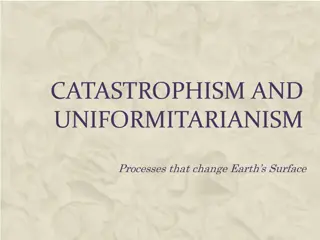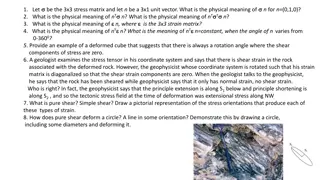Understanding Civil Engineering: Dams, Reservoirs, and Geological Considerations
Civil engineering work encompasses various structures like dams, embankments, motorways, bridges, buildings, and more. Building dams and reservoirs involves considerations of geological factors, rock properties, and structural design. Different types of dams, such as gravity dams and arch dams, serv
0 views • 23 slides
Earth's Surface Evolution: Catastrophism vs. Uniformitarianism
Catastrophism and uniformitarianism are two contrasting processes that have shaped Earth's surface over time. Catastrophism involves sudden, violent events like volcanoes and earthquakes, while uniformitarianism relies on gradual processes such as erosion. Geologists study these processes to underst
4 views • 13 slides
Exploring Careers in Geology: Opportunities and Pathways
Geology is the scientific study of the Earth's physical structure, substances, history, and processes. This field offers diverse career opportunities, from teaching and economic geology to environmental and engineering geology. Geologists play crucial roles in understanding natural hazards, explorin
0 views • 13 slides
PAMAV Report 2022: Advancing Mineral Asset Valuation in Europe
Polish Association of Mineral Asset Valuators (PAMAV) has been actively involved in the harmonization of Polish and international mineral resource reporting and valuation systems. The association's main activities in 2021/2022 include updating the POLVAL Mineral Resources Valuation Code, expanding t
0 views • 5 slides
Earth Science Quiz: Tectonic Plates, Mountains, and More!
Explore your knowledge of Earth's geology with this quiz covering topics like tectonic plate boundaries, famous geologists, mountain ranges, and geological processes. Test your understanding of concepts like convection currents, subduction, continental drift, and more in this engaging quiz.
0 views • 65 slides
Understanding Sedimentology: An Overview of Sedimentary Processes and Rocks
Sedimentology is the study of modern sediments like sand, mud, and clay, along with the processes involved in their deposition. Sedimentologists use this knowledge to interpret Earth's geologic history through sedimentary rocks and structures. Sediment plays a crucial role in enriching soil with nut
0 views • 27 slides
Understanding Earthquakes and Seismic Waves
This lecture delves into the nature and origin of earthquakes, discussing seismic waves, measurement techniques, effects of earthquakes on various Earth systems, and the relationship between earthquakes and plate tectonics. The content touches on topics like the impact of earthquakes on biosphere, h
0 views • 34 slides
Visuospatial Ability and Geologic Mapping Study
Explore the relationship between expertise levels in geosciences and visuospatial ability through a comprehensive five-year research project involving novice and expert geologists. Tasks, measures, and mapping techniques were utilized to assess domain knowledge and visuospatial skills.
0 views • 16 slides
Understanding Cut Slope Design and Topographic Surveying
Geotechnical engineers and engineering geologists play crucial roles in designing earth structures based on geological data. This involves assessing and forecasting hazards, making slope design recommendations, and more. The process includes topographic surveys, rock mass characterization, photogram
0 views • 11 slides
Understanding Metamorphic Rocks in 7th Grade Science
Metamorphic rocks are formed deep beneath the Earth's surface through heat and pressure, leading to changes in the rock's structure. Geologists classify these rocks based on grain arrangement into foliated (layered) and nonfoliated (random). Examples include slate, schist, gneiss, marble, and quartz
0 views • 6 slides
Understanding Biomarkers and Maturity Parameters in Petroleum Exploration
Biomarkers and maturity parameters play crucial roles in characterizing source materials and assessing the thermal maturity of organic matter in petroleum exploration. Specific biomarkers and non-biomarker maturity parameters are utilized to determine the relative maturity of source rocks and oils.
0 views • 17 slides
Evolution of GEO 303: A Large Geoscience Course in the 21st Century
Evolution and success of GEO 303, a large introductory geoscience course at the University of Texas at Austin. The course blends physical and historical geology, challenges students' pre-conceived notions, and encourages them to think like geologists. Team teaching, innovative instructional methods,
0 views • 8 slides
Introducing Python Programming Language to SMEDG Community
Python, a general-purpose, high-level, object-oriented programming language, is free, open-source, and easy to use. It was started in 1989 by Guido van Rossum and named after Monty Python's Flying Circus. With various releases and a thriving ecosystem of libraries, Python is fast to write, easy to r
0 views • 29 slides
Compositional Analysis of Rock-Forming Minerals Using Triangular Diagrams
Geologists frequently utilize triangular diagrams to determine mineral compositions in the Al2O3-SiO2-K2O system. This analysis helps identify stable minerals under Earth-surface conditions, considering primary weathering minerals. The process involves calculating mole percentages of oxides in miner
1 views • 25 slides
Introduction to Science and its Branches
Science is the organized way of gathering and analyzing evidence about the natural world. It encompasses various branches such as Biology, Earth Science, Chemistry, and Physics, each focusing on different aspects of the world around us. Careers in these fields range from doctors and nurses in Biolog
0 views • 25 slides
Understanding Rock Ages: A Geologic Perspective
Geologists determine the ages of rocks and the Earth using principles like Uniformitarianism, Relative Age, Law of Superposition, and Principle of Original Horizontality. By analyzing rock layers, sedimentary structures, and unconformities, they estimate Earth's age to be around 4.6 billion years ol
0 views • 15 slides
Understanding Strain and Stress: Concepts and Applications for Geologists and Geophysicists
This content delves into various aspects of stress and strain in the context of geology and geophysics, exploring the physical meanings of unit vectors, stress matrices, strain matrices, pure shear, simple shear, and their implications on deformation characteristics. It also discusses scenarios wher
0 views • 4 slides
















